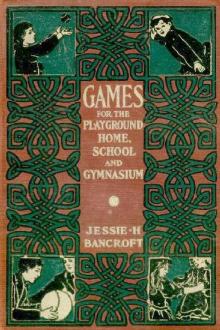Games for the Playground, Home, School and Gymnasium by Jessie Hubbell Bancroft (top novels of all time .txt) 📕

- Author: Jessie Hubbell Bancroft
- Performer: -
Book online «Games for the Playground, Home, School and Gymnasium by Jessie Hubbell Bancroft (top novels of all time .txt) 📕». Author Jessie Hubbell Bancroft
This may be made a very amusing little game to fill in a few dull moments, and when used in the schoolroom, it serves to refresh tired minds very quickly. The leader should speak and move very rapidly and make unexpected variations in the order in which the two commands are given.
I SPY3 to 30 or more players.
Out of doors; indoors.
One player is chosen to be the spy, who blinds his eyes at a central goal while the other players scatter and hide. The spy counts one hundred, upon the completion of which he announces his readiness to take up the hunt by shouting aloud:—
Look out for me,
For I am coming and I can see!"
Or he may shout only the word "Coming!" as he leaves the goal, or merely the last count, "One hundred!" The spy endeavors to detect as many hidden players as possible, and for each player must dash back to the goal, hit it three times, and call out, "One, two, three for ----," naming the player. Should he make a mistake in identity, the player really seen and the one named by mistake are both free and may return to the goal without further danger. As soon, however, as a player knows he has been detected by the spy, he should race with the latter for the goal, and should he reach it first, should hit it three times and call out, "One, two, three for me!" Any player who can thus make the goal after the spy has started on his hunt may save himself in this way, whether he has been detected or not. Should all of the players save themselves in this way, the same spy must blind for the next game. This, however, seldom happens. The first one caught by the spy, that is, the first one for whom he touches the goal, becomes spy for the next game.
JACK BE NIMBLE10 to 60 players.
Indoors; out of doors; schoolroom.
This game is suitable for very little children. Some small object about six or eight inches high is placed upright on the floor to represent a candlestick. This may be a small box, a book, bottle, or anything that will stand upright; or a cornucopia of paper may be made to answer the purpose. The players run in single file and jump with both feet at once over the candlestick, while all repeat the old rhyme:—
Jack be quick,
And Jack jump over the candlestick."
When there are more than ten players, it is advisable to have several candlesticks and several files running at once. In the schoolroom there should be a candlestick for each two rows of players, and these should encircle one row of seats as they run.
JACOB AND RACHEL10 to 30 or more players.
Playground; gymnasium; parlor.
All of the players but two form a circle with clasped hands. The two odd players are placed in the center, one of them, "Jacob," being blindfolded. The object of the game is for Jacob to catch the other player, "Rachel," by the sound of her voice; but Rachel is supposed to be rather coy, and to do all in her power to avoid being caught by Jacob, even though she answer his questions.
Jacob begins the game by asking, "Rachel, where art thou?" Rachel replies, "Here am I, Jacob," and immediately tiptoes to some other point in the ring, trying to evade Jacob's outstretched hands as he gropes for her. Rachel may stoop to evade being caught, or may dash from one side of the ring to the other, or resort to any tactics except leaving the ring. Jacob may repeat his question whenever he wishes, and Rachel must answer each time.
When Rachel is caught, Jacob returns to the ring, Rachel is blindfolded and chooses a new Jacob, this time taking the aggressive part and seeking him with the question, "Where art thou, Jacob?" etc.
When the game is played by both boys and girls, the names are used properly, but where all boys or all girls are playing, the same names are used, but one of the party is personated by a player of the opposite sex.
JAPANESE CRAB RACE2 to 60 or more players.
Gymnasium; playground.
If there be but few players for this game, it may be played as a simple race, without the relay feature, as here described. For large numbers the relay idea will be advisable.
The players are lined up behind a starting line, in from two to five single files, each containing the same number. Opposite each file, at a distance of from twenty-five to forty feet, there should be drawn a circle about three feet in diameter. The game consists in a race run backward on feet and hands (or "all fours") to the circles. To start, the first player in each file gets in position, with his heels on the starting line and his back to the circle for which he is to run; and all start together at a signal, the player who first reaches his circle scoring one point for his team. Others follow in turn.
Until one has tried this, it would be difficult to realize how thoroughly the sense of direction and the power to guide one's movements are lost while running in such a position. It is one of the jolliest possible games for the gymnasium.
JAPANESE TAG4 to 60 or more players.
Indoors; out of doors.
One player is chaser, or It, and tries to touch or tag all of the other players, the one tagged then becoming chaser. In this form of the game, however, whenever a player is touched or tagged, he must place his left hand on the spot touched, whether it be his back, knee, elbow, ankle, or any other part of the body, and in that position must chase the other players. He is relieved of this position only when he succeeds in tagging some one else.
As in other tag games where there are large numbers of players, several players may take the part of the tagger, or It, at the same time.
JOHNNY RIDE A PONY10 to 60 players.
Playground; gymnasium.
This is a game of leapfrog. The players are divided into two even parties, except for one leader, one party being the ponies and the other the riders, or Johnnies. The ponies form one long back as follows: one player stands upright against a wall or fence; the first back stoops in front of this leader, bracing his head against him; the other players grasp each the waist of the player in front, and stoop with the heads against him or turned to one side (away from the jumper). When the backs (ponies) are ready, the riders all run toward them from the side, each rider vaulting from the side on to the back of one pony. The ponies try in every way, except by straightening up, to throw their riders while the leader counts fifty. If a rider be made to touch even one foot to the ground, the ponies have won and score a point, the riders exchanging places with them. If the ponies fail in this attempt, they must be ponies again. The side wins which has the highest score at the end.
JUMPING RELAY RACE10 to 60 or more players.
Playground; gymnasium; schoolroom.
The players are lined up in several single files behind a starting line which is drawn at from ten to fifty feet from a finishing line which should be parallel to it. At a signal the first players in each file, who have been standing with their toes on the starting line, jump forward with both feet at once and continue the jumping to the finish line, when they turn and run back to the starting line. Each player, on returning to the starting line, should touch the hand of the next player in his file, who should be toeing the line ready to start, and should begin jumping as soon as his hand is touched by the return player. The first jumper goes at once to the foot of the line, which moves up one place each time that a jumper starts out, so that the next following player will be in position on the line.
The file wins whose last player first gets back to the starting line.
3 to 100 players.
Playground; gymnasium.
Jumping a rope is admirable for both boys and girls, combining much skill with invigorating exercise. It should always be done on the toes, with a "spring" in the ankles and knees to break the jar, and should not be carried to a point of exhaustion. It may be made one of the most interesting competitive games for large numbers, lined up in relay formation and jumping in turn over a long rope. There should then be one rope for each line. A score should be kept for each team, each feat successfully performed by a player scoring one point for his or her team. For each round, each player in all teams should perform the same feat.
The different series following are for:—
Small single rope. One large rope. Two large ropes. Large single rope and small individual rope.The small single rope or individual rope should be about six feet long for the average player. A good general rule is to have it just long enough to reach to the shoulders on each side while the player is standing on it.
A rope not made with handles at the ends should have a knot tied at either end, to prevent untwisting and to give a firm hold. Every jumper knows how to twist the ends around the hands to make shorter a rope that is too long.
A long rope should be heavy and from ten to twenty feet in length. It should be turned by two players while one or more jump, as indicated. When not used for athletic competition, any player failing in the jumping should change places with one of the turners; that is, should "take an end."
I. Small Single Rope1. Standing in one place, the jumper turns the rope forward and jumps on the toes of both feet for from ten to twenty-five counts. Prolonged jumping beyond this number to the point of exhaustion should not be done.
2. Standing in one place, jump five counts on one foot and then five on the other.
3. Jump as in 1 and 2, but turn the rope backward instead of forward.
4. Running and skipping, the rope turned forward.
5. Running and skipping, the rope turned backward.
6. Running and skipping, one player in the rope and two others running and turning the rope. The one who is skipping repeats the verse:—
Butterfly, butterfly, touch the ground;
Butterfly, butterfly, show your shoe;
Butterfly, butterfly, twenty-three to do.
7. All of the above with two jumpers, each turning one end of the rope, the inner hands resting on each other's shoulders.
8. As in 7, but with two jumpers, one standing behind the other instead of side by side, a hand of the rear jumper being placed on a hip of the one in front. Each turns one end





Comments (0)